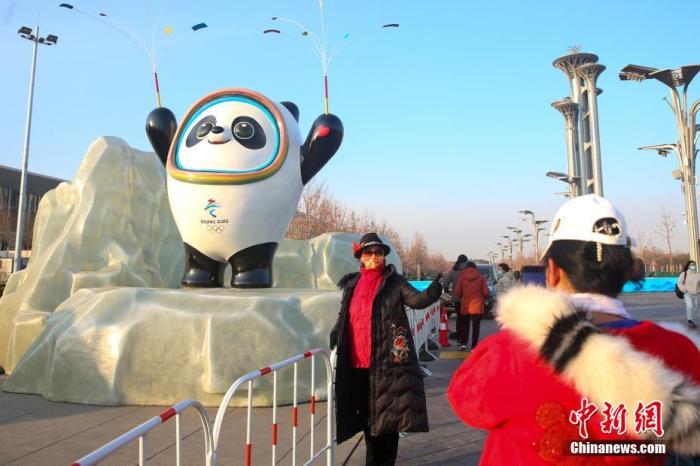(Beijing Winter Olympics) From "Panpan" to "Bingdundun", why is the giant panda recognized as the "spokesperson" of China's image in the world?
China News Service, Beijing, January 20 (Wu Kan Yangliu) As an important element of the visual image system of the Beijing Winter Olympics, the mascot "Bing Dun Dun" has been widely concerned and loved since its birth.
"Bingdundun" combines the image of the giant panda with the ice crystal shell, which reflects the characteristics of winter ice and snow sports and modern technology, and implies creating extraordinary and exploring the future.
On January 16, on Datun Road, Beijing, the mascot of the Beijing 2022 Winter Olympics "Bing Dun Dun" attracts passers-by to take photos and punch cards.
Photo by China News Agency reporter Yi Haifei
In fact, from "Panpan", the mascot of the Beijing Asian Games in 1990, to "Jingjing", one of the mascots of the 2008 Beijing Olympic Games, to "Bingdundun", the mascot of the Beijing Winter Olympics, the giant panda has become an international The recognized "spokesperson" of China's image is also one of the most recognized Chinese cultural symbols overseas.
What kind of Chinese cultural connotation does the giant panda contain?
Why is it recognized internationally?
Wan Anlun, a professor at the School of Journalism and Communication of Beijing Normal University, said in an interview with a reporter from China News Agency that the giant panda is a species unique to China, and it is also in line with China's cultural connotation.
"Specifically, the giant panda is gentle and amiable, which means gentleness, peace and unity; its black and white appearance also matches the Taoist yin and yang shape; in addition, as China's national treasure, the giant panda also contains the meaning of harmonious coexistence between man and nature. " Wan Anlun said.
As one of the symbols of Chinese culture, giant pandas have always played an important role in international communication.
Wan Anlun said: "There are three reasons for the high recognition of giant pandas in the world: first, their rarity; second, their peaceful and friendly cultural connotations; ."
In Wan Anlun's view, the international dissemination of the giant panda image is also a journey of "cuteness" of Chinese cultural symbols in the world. The giant panda is gentle, cute, elegant, lively, and relaxed. It is a popular symbol that needs no modification.
"A major obstacle in international communication is the difference of language and symbols. In the Internet and digital age, animal image media represented by giant pandas can bridge the gap between language and symbols and play a role in international communication." Wan An Lun said.
He said that "Panda Image Media", "Panda Cultural Symbol" and "Panda Diplomatic Strategy" are of great significance to China's international image building.
北京2022年冬奥会和冬残奥会吉祥物“冰墩墩”、“雪容融”亮相北京北辰路。 中新社记者 易海菲 摄
随着时代的发展演进,人们的审美标准发生变化,国际传播中的熊猫形象随之发展演化,不断创新的熊猫形象也传递着中国新形象。
1990年北京亚运会,手持金牌做奔跑状的大熊猫“盼盼”凭借可爱可亲的形象风靡亚洲,成为经典的时代记忆。2008年北京奥运会吉祥物之一“福娃晶晶”的色彩与灵感来源于奥林匹克五环的黑色一环,传递友谊、和平、积极进取的精神。
北京冬奥会吉祥物“冰墩墩”的整体形象酷似航天员,头部外壳造型取自冰雪运动头盔,装饰彩色光环,灵感源自于北京冬奥会的国家速滑馆——“冰丝带”,流动的明亮色彩线条象征着冰雪运动的赛道和5G高科技。
谈到“冰墩墩”形象的创新时,北京奥运城市发展促进会副会长蒋效愚曾表示,“冰墩墩”向世界展现了中国人民敦厚、勤劳、和善的形象,同时它又是面向未来、包含科技元素的熊猫,展现中国面向未来的充分自信。
在万安伦看来,“冰墩墩”形象也是打造奥运IP的绝佳素材。“它不仅可以与各种冰雪运动相结合,还可以在玩具模型、服装服饰、文学形象、动漫角色、元宇宙空间等领域一展风采,相信‘冰墩墩’还能衍生出更多的可能性。”(完)

